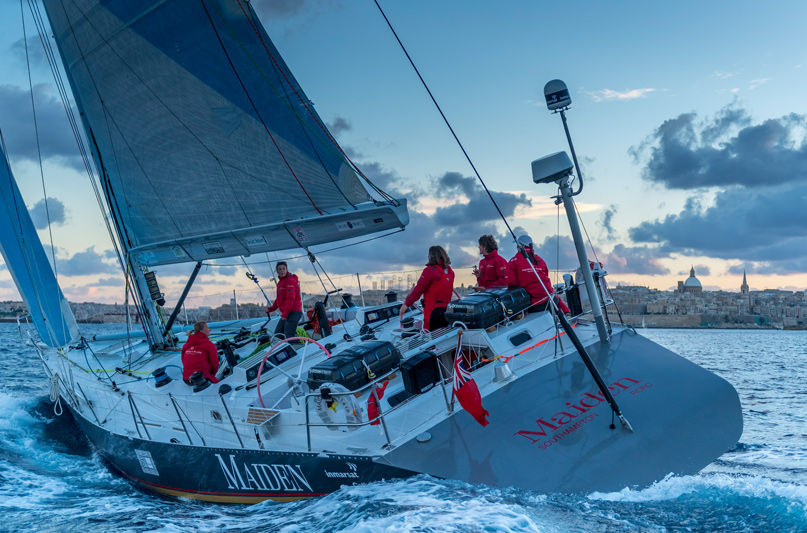
What secrets are hidden in the names of famous boats? Maiden was the self-deprecating name of the first ocean-racing team crewed solely by women back in 1988. Their goal wasn’t to get their feet wet by merely crossing an ocean in the trade winds, it was to go straight for the biggest offshore prize of that era—the Whitbread Round the World Race (later to become the Volvo Race). It was a hugely ambitious project literally dreamed up by a young English sailor, 24-year-old Tracy Edwards, with practically no experience of managing such an undertaking.
She was a rebellious teenager who drifted through Europe, ending up in Greece, and taking the only job available to women on big sailing yachts at the time—a cook. She took the skills she learned in the galley into the 1985-86 Whitbread Race aboard Atlantic Privateer, an 80’ Farr sloop. She not only survived working in the galley through the “roaring forties” and round Cape Horn, she finished the race determined to take part three years later, but as a skipper with the first female crew.
She overcome every barrier put up by the sexist yachting establishment, which disparaged her efforts at every step of the long journey, and reached the starting line in Cowes, the English home of yachting, after a frantic final push to fit out her boat. Maiden was a 58-foot aluminum design that previously completed the race, and remarkably, her sponsor was King Hussein of Jordan and Royal Jordanian Airlines. That is another entire story itself, as are the success these 12 women had during the grueling year-long event from 1989-1990.
The crew included Americans Dawn Riley, who went on to lead her own women’s crew in America’s Cup and Whitbread races, and Amanda Swan Neal, who runs Mahina, a world cruising and sail training business based in the Pacific Northwest, with her husband John Neal. Maiden finished second in her class, winning two out of six individual legs of the race, including Cape Town to Auckland, the best finish by a British boat for 17 years. Edwards was awarded the Yachtsman of the Year Trophy, the first woman to receive it.
How is all this news? Tracy Edwards is once again inspiring a new generation of women to dream of fair winds and far islands. Although the news has barely reached U.S. shores, the Maiden phenomenon has been revived and is sailing to Seattle from New Zealand, attracting crowds and the media everywhere they go.
Like a pied piper, Edwards has done the impossible again and this time she has the power of modern social media behind her. This story begins with the boat, found derelict in the Seychelles Islands in the Indian Ocean and returned to England in 2017 after a fundraising drive. There she was lovingly restored by craftsmen and volunteers in the same English boatyard where she had been refitted in 1988. The boat itself was designed by Bruce Farr under IOR rule with a displacement of 21 tons, and built in 1979 for Swiss skipper Pierre Fehlmann. He raced under the sponsorship of a cigarette maker and the boat, named Disque D’Or 3, finished fourth overall in the 1981 to 1982 Whitbread Race. A year later, it was renamed Stabilo Boss for the 1986-87 BOC single-handed race, and came in seventh, skippered by South African Bertie Reed.

Now Maiden’s journey is continuing in a different tack. In 2018, she departed on another voyage around the world crewed by young women from many nations and backgrounds and is stopping at as many ports as possible to welcome young fans on board and raise funds and awareness for girls’ education.
Before her arrival in the Pacific Northwest, she will be preceded by a hourlong documentary film first released in the United Kingdom on March 8 to coincide with International Women’s Day. It is schedule to be available here in July, both online and in theaters. Luckily in the now famous Whitbread race, Maiden had a cine-camera aboard, not a typical piece of onboard equipment in 1989. There is plenty of exciting, heart-pounding footage from the race, resulting in an uplifting, inspiring film that has won rave reviews.
In the film, Edwards, is not afraid to admit she made mistakes, like the choice of the women to wear swimsuits for their finish in Fort Lauderdale, which she explains tongue in cheek was “to distract the press from their third-place position in leg 5.” Apparently, it was the most syndicated sports photograph of the year. Society has since become more liberal of women in sport showing some skin, such as modern beach volleyball in the Olympics.
And yes, the same gender issues continue in offshore sailing. Although women have made great progress in inshore sailing in the last 30 years, they are still struggling to find their footing in the elite offshore world.
This year, the organizers of the next version of the original Whitbread Race have issued a penalty that reduces the number of male crew allowed if teams choose to sail without women on board.
You can learn more about Maiden’s journey and Pacific Northwest arrival via their website, The Maiden Factor. The current sail plan calls for a Vancouver visit from July 28 to August 6 and a Seattle stay August 6 to August 16 before heading south to San Francisco.


